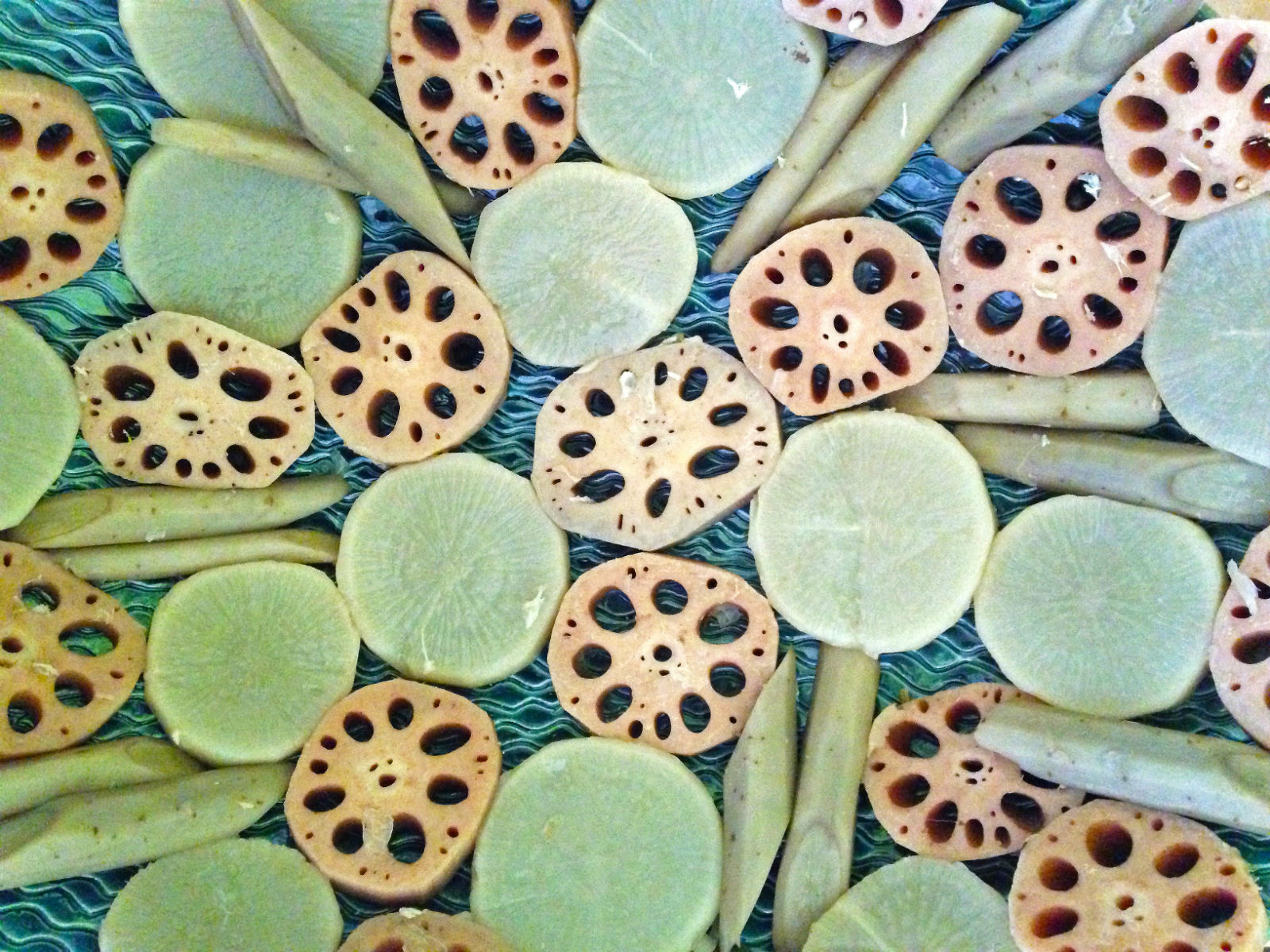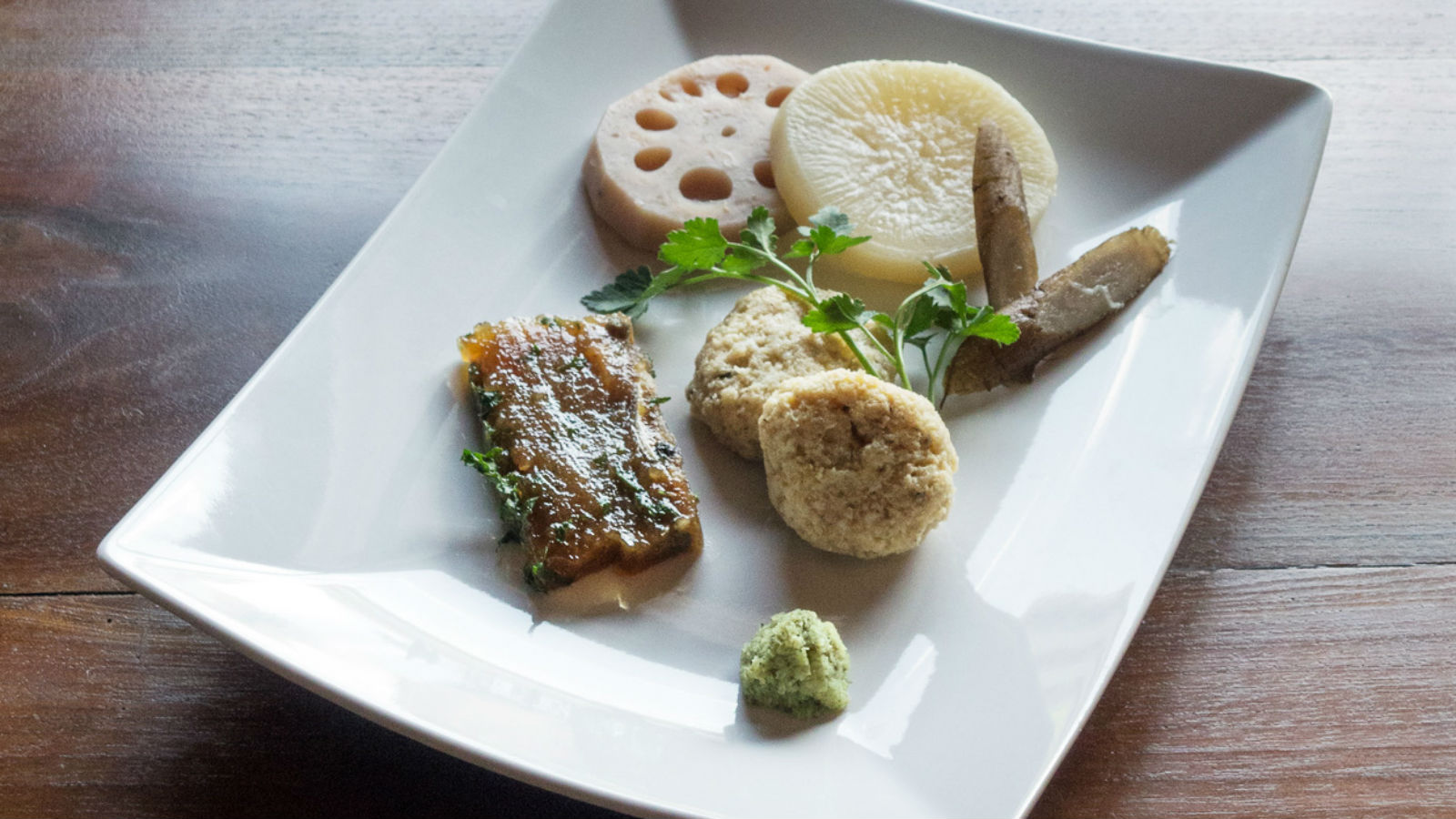Traveling to Japan was a palate-changing experience. Even foods I had tasted before were so excellently prepared and of such high quality there that I felt like I was trying them for the first time. Fresh wasabi grated right off the root is bright and grassy, incomparable to the tube or powder kind. Tofu is neither bland nor dull, but is buttery and creamy, and with a distinctive soy bean flavor. Handmade noodles for udon and ramen are thick, chewy, and silky. I could go on and on about the foods I enjoyed there.
I came back to the U.S. eager to adapt the lessons I had learned in Japan into my everyday cooking. Yuzu made appearances into sauces and marinades with its bright citrus flavor and pungent floral notes. Miso got added to soups, fish, and meat dishes. I began using sake to steam chicken. And then there was the Jewish food…
Whenever I travel anywhere, I seek out Jewish cooks and their food, and Japan was no exception. There are in fact Jewish communities in Japan, and some Jews have been living there for multiple generations. The Jewish cooks I met were all incorporating Japanese ingredients and techniques into both Ashkenazi and Sephardic culinary traditions. While picking a favorite dish from my travels is almost impossible, trying Japanese-style gefilte fish is the dish that left the biggest impression.

The Nosher celebrates the traditions and recipes that have brought Jews together for centuries. Donate today to keep The Nosher's stories and recipes accessible to all.
During the day The Pink Camilla, an Israeli bistro in the heart of Tokyo, is filled with soft daylight streaming through large windows into a small dining room with an open kitchen located on the second floor of an unassuming building. The tables are made of dark wood, and the shelves are lined with fine Israeli wines.
Marcelo Rubach is the chef and owner of the restaurant. Over six feet tall, his large stature matches his magnetic energy and charisma. He operates the restaurant in partnership with his Japanese wife, Mayuku. Meeting them instantly felt like meeting old friends, and within seconds of speaking their passion for their food and their energy towards their business was clear. Marcelo identifies himself firstly as an Israeli Jew, and currently as a longtime resident of Japan, but he is also of Moroccan and Brazilian descent. He has lived in Israel, Brazil, Canada, and Japan. In fact, it was in Montreal that he met and fell in love with Mayuku. They ultimately decided to make Tokyo their home. Marcelo’s dream was to bring the best cooking of Israel to Japan, and to pair that food with Israel’s best wines. He has made that dream a reality.
At his bistro, Marcelo sticks to traditional fine-dining Israeli fair, specializing in aged steaks, but in his home-life, Marcelo makes both traditional Jewish dishes and Japanese-influenced food. For Shabbat Marcelo bakes homemade challah. When he is hungry for a quick dish, he makes an unusual combination of natto (fermented soybeans) with kimchi, egg, aged steak, and olive oil.
Among his Japanese-influenced Jewish dishes, one of his favorites is his recipe for gefilte fish. He makes his uniquely Japanese-style gefilte fish for every Jewish holiday. Marcelo’s recipe for gefilte fish may simply be a product of necessity; he uses the ingredients that are around him — bonito flakes, lotus root, and fresh wasabi. Or maybe, Marcelo understands that if he wants to share a beloved dish with his Japanese friends and family, he can make it more palatable by developing the recipe to include the flavors and tastes of the local cuisine.

Gefilte fish is often made with carp, but carp is considered a sacred fish in Japan and so Marcelo uses cod instead. Because bonito and shiitake have such rich umami flavors, he uses those ingredients as a base for his poaching broth as opposed to traditional Western-style fish stock. Because lotus root, daikon, and burdock are abundant in any Japanese kitchen he uses them instead of onion, carrot, and celery. Because it tastes incredible and has the sharpness of white horseradish, Marcelo serves his gefilte fish with freshly grated wasabi. And because it is so good, he makes this gefilte fish recipe over and over again and no one is complaining.
When I got back from my trip to Japan, Passover was just around the corner. I knew exactly what I was serving for the fish course. I wasn’t surprised that when I served this dish it converted even the biggest gefilte fish skeptics and resistors at the table. The recipe is a labor of love, with multiple steps and components. The ingredients also might take a bit of extra hunting to find. I was able to get them all at a local Japanese market, and many of the ingredients are available at other Asian markets, too. Among the extra steps, Marcello serves his gefilte fish alongside a terrine made from the broth he cooks the fish patties in. You can absolutely skip this step and just make the patties, or you can go for the full effect and take this gefilte fish dish to another level.
The following recipe is shared with permission from Chef Marcelo Rubuch.
Ingredients
For the broth:
- 1 gallon (3¾ liters) of water
- 1 6” piece lotus root, peeled and cut into rings 1.5” thick*
- 1 6” piece of daikon, peeled and cut into 1.5” thick
- 2 15” burdock roots, peeled and cut into 2” pieces on the bias*
- 1 large yellow onion, sliced into thick rings
- 1 Tbsp black peppercorns
- 1 (10 g) packet dashi stock powder made with bonito, or 1 fish bouillon cube]10 dried shitake mushrooms, or 1 (6 g) packet dried shitake powder
- ½ lb. (250 g) cod fish, skinless and filleted, cut into 1” chunks
- salt, to taste
For the terrine:
- 1½ (.25 oz/7 g) packet of powdered unflavored gelatin (preferably kosher fish gelatin)
- 3 Tbsp chopped Italian parsley
For the gefilte fish:
- 1½ lbs. (700 g) cod fish, skinless and filleted, and cut into 2-inch chunks
- 1 onion, cut into small chunks
- ½ cup matzah meal, soaked in ½ a cup of water
- 2 large eggs
- 1 tsp table salt
- 2 tsp sugar
- ½ tsp freshly ground pepper
For the garnish:
- wasabi paste
- white prepared horseradish
- red prepared horseradish
fresh flat leaf parsley
Directions
- To make the broth: Fill a large stockpot with water. Add the peeled and cut lotus root, daikon, burdock root, onion, peppercorns, dashi powder, and dried shitake to the pot. On high heat, bring everything to a simmer.
- Be careful not to boil the broth. Simmer the broth for 45-60 minutes, or until all of the vegetables are tender.
- Once the vegetables are fully cooked and tender, remove them from the broth and reserve. Taste the broth and season with salt and pepper, to your liking.
- To make the gefite fish: While the broth is simmering, prepare your fish patties. If you are using matzah meal, start by soaking the matzah in ½ a cup of water while you make your fish and onion mixture.
- Pat your fish fillets dry with paper towels or a clean kitchen towel, and cut it into 2” chunks. Cut your onion in half and then into quarters.
- Using a food processor, add the chopped onion and pulse it into a fine mince. Once the onion is minced, add the pieces of cod and pulse the fish with the onions until it is broken down into fine bits and starts to form a paste; be careful not to over mix the onion and fish mixture.
- Transfer the onion and fish mixture into a large bowl.
- To the fish mixture, add the soaked matzah meal, eggs, salt, sugar, and pepper. Combine everything together using your hands. If it feels too loose, add more matzah meal (at this point dry will work). Your mixture should be moist, but it should hold together when formed into a small patty.
- Form the fish into small 2” in diameter patties. Use your hands or an ice cream scoop to form the patties. Once you have formed all of the patties, you can start cooking them in the simmering broth.
- Make sure the broth is still simmering and that all of the vegetables have been removed from the pot. Turn the heat to medium or medium high, as the temperature will drop once you add the fish. Add the fish patties in batches so as not to overcrowd the pot. Let them cook in the broth for 6-8 minutes. When they are fully cooked, they will float to the top of the broth. With a slotted spoon, carefully remove each fish patty and reserve.
- Once all of the patties have cooked, continue to simmer your broth until it reduces by a half or two thirds. You want to reduce the broth until you have about 3 cups of rich reduced broth left in the pot. Once your broth has reduced, add the remaining pieces of fresh cod fish to the pot.
- While the fish is simmering, prepare the gelatin. Use 1½ packets of unflavored gelatin. Kosher gelatin can be ordered online through specialty markets. Place the gelatin in a small bowl and add a few tablespoons of cold water to the powder.
- Let the gelatin sit for 5 minutes or until it starts to set. Let the broth simmer just until the fish is fully cooked, about 5 minutes. Once cooked, the fish will start to flake apart slightly. At this point, turn the heat off. Taste and season the broth with salt and pepper, to your liking. Add the gelatin to the hot pot of liquid, and stir it into the broth until fully dissolved.
- Line a 11 X 6 X 4¾ terrine pan with plastic wrap. If you do not have a terrine dish, you can use a loaf pan, or any container that will hold the 3 cups of liquid and fish. The idea is to have a vessel that will allow for even slicing of the finished fish terrine when it firms up.
- Pour the broth and cod fish into the terrine. Sprinkle the top with freshly chopped flat leaf parsley. Allow the terrine to set overnight in the fridge.
- The terrine and gefilte fish should be made 1-3 days before serving.
- To assemble your gefilte fish: Slice your terrine into ½” slices. Place a slice of terrine on a plate, and add one slice of daikon, lotus root, and 2 slices of burdock to the plate. Place 2 gefilte fish patties on the same plate. Garnish with fresh flat leaf parsley, wasabi paste, and both white and red horseradish.
- Alternatively, this dish can be arranged and plated family style on a large platter with the wasabi and horseradish served on the side.
Note: Lotus and Burdock root can be found at Japanese or Asian markets. If you cannot locate lotus or burdock root, you can substitute either or both with these with parsnip, turnip, or rutabega.
Powdered dashi and dried shitake powder can be found at Japanese or Asian markets. If you cannot find these items, you can substitute the bonito with fish bouillon or fish stock, and the dried shitake powder can be substituted with whole dried shitakes.



